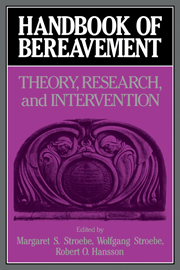Book contents
- Frontmatter
- Contents
- Contributors
- Preface
- Part I Introduction
- Part II The phenomenology and measurement of grief
- Part III Current theories of grief, mourning, and bereavement
- Part IV Physiological changes following bereavement
- Part V The psychological, social, and health impacts of conjugal bereavement
- Part VI Grief reactions to different types of loss
- Part VII Coping, counseling, and therapy
- 23 The meaning of loss and adjustment to bereavement
- 24 Old age and widowhood: Issues of personal control and independence
- 25 The support systems of American urban widows
- 26 The role of social support in bereavement
- 27 Bereavement self-help groups: A review of conceptual and methodological issues
- 28 Counseling and therapy of the bereaved
- Part VIII Conclusions
- References
- Author index
- Subject Index
27 - Bereavement self-help groups: A review of conceptual and methodological issues
Published online by Cambridge University Press: 04 May 2010
- Frontmatter
- Contents
- Contributors
- Preface
- Part I Introduction
- Part II The phenomenology and measurement of grief
- Part III Current theories of grief, mourning, and bereavement
- Part IV Physiological changes following bereavement
- Part V The psychological, social, and health impacts of conjugal bereavement
- Part VI Grief reactions to different types of loss
- Part VII Coping, counseling, and therapy
- 23 The meaning of loss and adjustment to bereavement
- 24 Old age and widowhood: Issues of personal control and independence
- 25 The support systems of American urban widows
- 26 The role of social support in bereavement
- 27 Bereavement self-help groups: A review of conceptual and methodological issues
- 28 Counseling and therapy of the bereaved
- Part VIII Conclusions
- References
- Author index
- Subject Index
Summary
Exploring the benefits of self-help or mutual aid groups for the bereaved requires the prior examination of the bereaveds' social and psychological dilemmas and how these interact with the special characteristics of self-help groups (SHGs). This chapter addresses the following questions: What are SHGs? How do they work? What are the special problems of the bereaved? How do these interact with SHG processes to create a setting helpful to the bereaved? What is the empirical evidence that SHGs are useful in addressing problems of bereavement?
The designation self-help group is commonly applied to a wide variety of activities. SHGs are described as support systems, as social movements, as spiritual movements and secular religions, as systems of consumer participation, as alternative, care-giving systems adjunct to professional helping systems, as intentional communities, as supplementary communities, as expressive-social influence groups, and as organizations of the deviant and stigmatized (Killilea, 1976). Self-help, or mutual aid, groups are a poorly defined and unbounded area; arbitrary judgments rather than conceptual structure are the rule. In this chapter the working definition of SHG emphasizes (1) membership composition, people who share a common condition, situation, heritage, symptom, or experience; (2) self-governing and self-regulating; and (3) values, self-reliance and accessibility without charge.
SHGs are used extensively for a variety of problems. Mellinger and Baiter (1983) and Lieberman (1986), using a national probability sample of more than 3,000 households, reported on 1 year's utilization rate.
- Type
- Chapter
- Information
- Handbook of BereavementTheory, Research, and Intervention, pp. 411 - 426Publisher: Cambridge University PressPrint publication year: 1993
- 14
- Cited by



